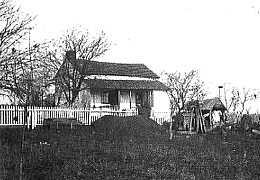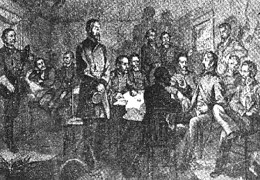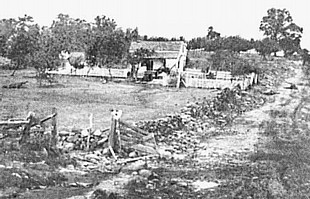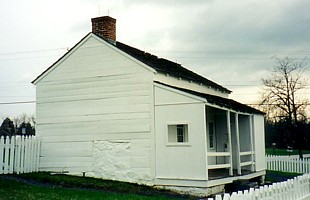|
Battle of Gettysburg Council of War
| The home of Lydia Leister near Gettysburg. |

|
| National Archives |
As the last shots of the day faded that night, a contingent of weary officers rode into the yard of Lydia
Leister's home. Situated on the Taneytown Road behind Cemetery Ridge, this humble two-room house served as headquarters for the Army of the Potomac. A modest, wood frame building with a single fireplace, the widow Leister made her living by working a small
farm that included a small log barn, orchard, and vegetable garden. By the evening of July 2, the widow's fences had been
partially knocked over and the garden trampled by the passage of courier's horses. Leister's food stores had been raided by
hungry staff officers and headquarters guards, and some of her furniture dragged into the yard for use as writing desks. Now
her home was host to one of the most important meetings that would take place during the battle.
| The Council of War in the Leister House. |

|
| National Archives |
Stamping the mud from their boots on the porch, the officers entered
the small room lit only by several flickering candles. Seated at the table to make notes was Maj. General Daniel Butterfield,
Meade's chief of staff who had served General Hooker in that capacity and remained on the staff at Meade's request.
Taking seats around the room was a host of generals: John Newton, newly assigned to command the First Corps after the end
of the fighting on July 1; John Gibbon, in charge of the Second Corps; David B. Birney, in command of the Third Corps after
the wounding of General Sickles; George Sykes, whose Fifth Corps had seen so much of the fighting that day; John Sedgwick,
the bright eyed commander of the newly arrived Sixth Corps; O.O. Howard, who's battered Eleventh Corps had settled on Cemetery
Hill; Alpheus Williams, temporary commander of the Twelfth Corps; Henry Slocum, a bitterly honest and dedicated officer who
believed in standing one's ground; and Winfield S. Hancock, the reliable corps commander whose battlefield expertise and command decisions had saved the day on the Union left. Also
among the group was an exhausted General Warren, the "savior of Round Top", who slumped to the floor and rapidly fell asleep as the meeting began. General Mead listened intently as his
corps commanders reported the conditions of their respective fronts and expressed opinions on what the Confederates may be
devising for another day of battle.
| Gen. Gibbon |

|
| Generals in Blue |
Junior in rank to the other officers in the room, John Gibbon listened carefully to the discussion of each corps commander and later recalled the experience: "The discussion
at first was very informal and in the shape of conversation, during which each one made comments on the fight and told what
he knew of the condition of affairs. In the course of this discussion, Newton expressed the opinion that, 'this was no place
to fight a battle in.' General Newton was an officer of engineers and was rated by me, and I suppose by most others, very
highly as a soldier. The assertion, therefore, coming from such a source, rather startled me and I eagerly asked what his
objections to the position were. The objections he stated... related to some minor details of the line, of which I knew nothing
except so far as my own front was concerned. But the prevailing impression seemed to be that the place for the battle had
been in a measure selected for us. Here we are; now what is the best thing to do?"
| The Leister House soon after the battle had ended. |

|
| Library of Congress |
The discussion continued for several minutes until General Butterfield suggested that the question be formally
asked to the members of the council. Three questions were asked, including whether the army should remain at Gettysburg or
retire to a better position, wait for Lee to attack or attack him, and how long should the army wait before striking Lee? Almost to a man, the officers
agreed to correct any awkward positions in the line and remain on the field for another day. Due to the heavy casualties in
three of Meade's army corps, they deemed it best to wait for Lee to attack before moving against him. The last officer to
comment, General Henry Slocum, put it quite succinctly: "Stay and fight it out!"
With the decisions made, the council of war ended. The generals paid their
respects as they prepared to return to their troops, each striding out the door into a yard filled with horses and orderlies.
General Gibbon was about to leave when he was suddenly confronted by the army commander:
"Before I left the house Meade made a remark to me which surprised
me a good deal, especially when I look back upon the occurrence of the next day. By a reference to the votes in the council...
the majority of the members were in favor of acting on the defensive and awaiting the action of Lee. In referring to the matter,
just as the council broke up, Meade said to me, 'If Lee attacks to-morrow, it will be on your front.' I asked why he thought
so and he replied, 'Because he has made attacks on both our flanks and failed, and if he concludes to try it again it will
be on our center.' I expressed the hope that he would, and told General Meade, with confidence, that if he did we would defeat
him."*
| The Leister House today. |

|
| Gettysburg NMP |
Meade's words were prophetic. Lee would indeed attack on July 3rd, but not
as the Confederate commander had planned that same evening in his own council. The next great blow would fall against the
Union center in what has become known as the greatest charge of the war.
Widow Leister's House Today
*(General Gibbon's account was written in 1887 and first published in the
"Philadelphia Weekly Press" and later reprinted in the monumental series, Battles and Leaders of the Civil War.)
Sources: Gettysburg National Military Park;
Library of Congress; National Archives and Records Administration; National Park Service; Official Records of the Union and Confederate Armies
Recommended Reading: Gettysburg: A Testing of Courage. Description:
America's Civil War raged for more than four years, but it is the three days of fighting in the Pennsylvania countryside in
July 1863 that continues to fascinate, appall, and inspire new generations with its unparalleled saga of sacrifice and courage.
From Chancellorsville, where General Robert E. Lee launched his high-risk campaign into the North, to the Confederates' last
daring and ultimately-doomed act, forever known as Pickett's Charge, the battle of Gettysburg gave the Union army a victory
that turned back the boldest and perhaps greatest chance for a Southern nation. Continued below...
Now, acclaimed historian Noah Andre Trudeau brings the most up-to-date research
available to a brilliant, sweeping, and comprehensive history of the battle of Gettysburg that sheds fresh light on virtually
every aspect of it. Deftly balancing his own narrative style with revealing firsthand accounts, Trudeau brings this engrossing
human tale to life as never before.
Recommended Reading: Retreat from Gettysburg:
Lee, Logistics, and the Pennsylvania Campaign (Civil War America) (Hardcover). Description: In a groundbreaking, comprehensive history of the Army of Northern Virginia's retreat
from Gettysburg in July 1863, Kent Masterson Brown draws on
previously unused materials to chronicle the massive effort of General Robert E. Lee and his command as they sought to expeditiously
move people, equipment, and scavenged supplies through hostile territory and plan the army's next moves. More than fifty-seven
miles of wagon and ambulance trains and tens of thousands of livestock accompanied the army back to Virginia. Continued
below...
The movement
of supplies and troops over the challenging terrain of mountain passes and in the adverse conditions of driving rain and muddy
quagmires is described in depth, as are General George G. Meade's attempts to attack the trains along the South Mountain range and at Hagerstown and Williamsport, Maryland. Lee's deliberate pace, skillful
use of terrain, and constant positioning of the army behind defenses so as to invite attack caused Union forces to delay their
own movements at critical times. Brown concludes that even though the battle of Gettysburg
was a defeat for the Army of Northern Virginia, Lee's successful retreat maintained the balance of power in the eastern theater
and left his army with enough forage, stores, and fresh meat to ensure its continued existence as an effective force.
Recommended Reading: Commanding the Army of the Potomac (Modern War Studies) (Hardcover). Description: During the Civil War, thirty-six officers in the Army of the Potomac were assigned corps commands of up to 30,000 men. Collectively charged with leading the Union's
most significant field army, these leaders proved their courage in countless battlefields from Gettysburg
to Antietam to Cold Harbor. Unfortunately, courage alone was not enough. Their often dismal
performances played a major role in producing this army's tragic record, one that included more defeats than victories despite
its numerical and materiel superiority. Stephen Taaffe takes a close look at this command cadre, examining who was appointed
to these positions, why they were appointed, and why so many of them ultimately failed to fulfill their responsibilities.
Continued below...
He demonstrates
that ambitious officers such as Gouverneur Warren, John Reynolds, and Winfield Scott Hancock employed all the weapons at their
disposal, from personal connections to exaggerated accounts of prowess in combat, to claw their way into these important posts.
Once appointed, however, Taaffe reveals that many of these officers failed to navigate the tricky and ever-changing political
currents that swirled around the Army of the Potomac. As a result, only three of them managed to retain their commands for more than
a year, and their machinations caused considerable turmoil in the army's high command structure. Taaffe also shows that their
ability or inability to get along with generals such as George McClellan, Ambrose Burnside, Joseph Hooker, George Meade, and
Ulysses Grant played a big role in their professional destinies. In analyzing the Army of the Potomac's
corps commanders as a group, Taaffe provides a new way of detailing this army's chronic difficulties-one that, until now,
has been largely neglected in the literature of the Civil War.
Recommended Reading: ONE CONTINUOUS FIGHT: The Retreat from Gettysburg and the Pursuit of Lee's Army of Northern Virginia, July 4-14, 1863 (Hardcover) (June 2008). Description: The titanic three-day battle of Gettysburg left 50,000 casualties in its wake, a battered Southern army far from its base
of supplies, and a rich historiographic legacy. Thousands of books and articles cover nearly every aspect of the battle, but
not a single volume focuses on the military aspects of the monumentally important movements of the armies to and across the
Potomac River. One Continuous Fight: The Retreat from Gettysburg
and the Pursuit of Lee's Army of Northern Virginia, July 4-14, 1863 is the first detailed military history of Lee's retreat
and the Union effort to catch and destroy the wounded Army of Northern Virginia. Against steep odds and encumbered with thousands
of casualties, Confederate commander Robert E. Lee's post-battle task was to successfully withdraw his army across the Potomac
River. Union commander George G. Meade's equally difficult assignment was to intercept the effort and destroy his enemy. The
responsibility for defending the exposed Southern columns belonged to cavalry chieftain James Ewell Brown (JEB) Stuart. If
Stuart fumbled his famous ride north to Gettysburg, his generalship
during the retreat more than redeemed his flagging reputation. The ten days of retreat triggered nearly two dozen skirmishes
and major engagements, including fighting at Granite Hill, Monterey Pass, Hagerstown, Williamsport,
Funkstown, Boonsboro, and Falling Waters. Continued below...
President Abraham
Lincoln was thankful for the early July battlefield victory, but disappointed that General Meade was unable to surround and
crush the Confederates before they found safety on the far side of the Potomac. Exactly what Meade did to try to intercept the fleeing Confederates, and how the
Southerners managed to defend their army and ponderous 17-mile long wagon train of wounded until crossing into western Virginia on the early morning of July 14, is the subject of this study.
One Continuous Fight draws upon a massive array of documents, letters, diaries, newspaper accounts, and published primary
and secondary sources. These long-ignored foundational sources allow the authors, each widely known for their expertise in
Civil War cavalry operations, to describe carefully each engagement. The result is a rich and comprehensive study loaded with
incisive tactical commentary, new perspectives on the strategic role of the Southern and Northern cavalry, and fresh insights
on every engagement, large and small, fought during the retreat. The retreat from Gettysburg
was so punctuated with fighting that a soldier felt compelled to describe it as "One Continuous Fight." Until now, few students
fully realized the accuracy of that description. Complimented with 18 original maps, dozens of photos, and a complete driving
tour with GPS coordinates of the entire retreat, One Continuous Fight is an essential book for every student of the American
Civil War in general, and for the student of Gettysburg in
particular. About the Authors: Eric J. Wittenberg has written widely on Civil War cavalry operations. His books include Glory
Enough for All (2002), The Union Cavalry Comes of Age (2003), and The Battle of Monroe's Crossroads and the Civil War's Final
Campaign (2005). He lives in Columbus, Ohio.
J. David Petruzzi is the author of several magazine articles on Eastern Theater cavalry operations, conducts tours of cavalry
sites of the Gettysburg Campaign, and is the author of the popular "Buford's Boys." A long time student of the Gettysburg
Campaign, Michael Nugent is a retired US Army Armored Cavalry Officer and the descendant of a Civil War Cavalry soldier. He
has previously written for several military publications. Nugent lives in Wells, Maine.
Recommended Reading: General Lee's Army: From
Victory to Collapse. Review: You cannot say that University of North Carolina professor Glatthaar
(Partners in Command) did not do his homework in this massive examination of the Civil War–era lives of the men in Robert
E. Lee's Army of Northern Virginia. Glatthaar spent nearly 20 years examining and ordering primary source material to ferret
out why Lee's men fought, how they lived during the war, how they came close to winning, and why they lost. Glatthaar marshals
convincing evidence to challenge the often-expressed notion that the war in the South was a rich man's war and a poor man's
fight and that support for slavery was concentrated among the Southern upper class. Continued below...
Lee's army included the rich, poor and middle-class,
according to the author, who contends that there was broad support for the war in all economic strata of Confederate society.
He also challenges the myth that because Union forces outnumbered and materially outmatched the Confederates, the rebel cause
was lost, and articulates Lee and his army's acumen and achievements in the face of this overwhelming opposition. This well-written
work provides much food for thought for all Civil War buffs.
|

